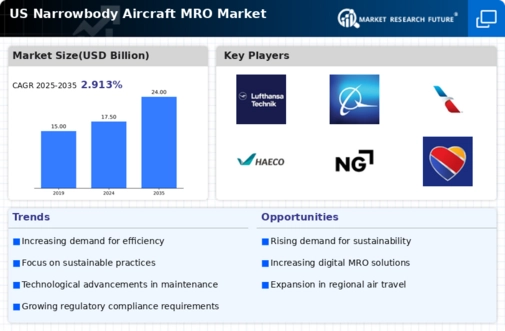Increasing Air Travel Demand
The narrowbody aircraft-mro market is experiencing a surge in demand due to the increasing air travel demand across the United States. As airlines expand their fleets to accommodate more passengers, the need for maintenance, repair, and overhaul services becomes critical. In 2025, the number of domestic air travelers is projected to reach approximately 800 million, indicating a robust growth trajectory. This heightened demand for air travel necessitates regular maintenance of narrowbody aircraft to ensure safety and reliability. Consequently, MRO providers are likely to see an uptick in service requests, thereby driving growth in the narrowbody aircraft-mro market. Airlines are investing heavily in MRO capabilities to minimize downtime and enhance operational efficiency, which further propels the market forward.
Fleet Modernization Initiatives
Fleet modernization initiatives are significantly influencing the narrowbody aircraft-mro market. Airlines are increasingly opting to upgrade their existing fleets with newer, more efficient narrowbody aircraft models. This trend is driven by the need to reduce operational costs and improve fuel efficiency. As of 2025, it is estimated that over 60% of narrowbody aircraft in the US will be less than 10 years old, necessitating advanced MRO services to maintain these modern fleets. The introduction of new technologies in aircraft design also requires specialized MRO services, which can adapt to the evolving needs of these aircraft. This modernization not only enhances the performance of airlines but also creates a substantial demand for MRO services tailored to newer aircraft models, thereby bolstering the narrowbody aircraft-mro market.
Expansion of MRO Service Providers
The expansion of MRO service providers is reshaping the landscape of the narrowbody aircraft-mro market. As the demand for MRO services grows, new players are entering the market, offering specialized services tailored to narrowbody aircraft. This influx of competition is driving innovation and improving service quality. In 2025, it is anticipated that the number of MRO service providers in the US will increase by 15%, leading to a more diverse range of service offerings. This expansion allows airlines to choose from a wider array of MRO solutions, enhancing their ability to meet specific maintenance needs. Furthermore, established MRO providers are also expanding their capabilities to include advanced technologies, which could further stimulate growth in the narrowbody aircraft-mro market.
Rising Focus on Operational Efficiency
A rising focus on operational efficiency among airlines is a key driver of the narrowbody aircraft-mro market. Airlines are increasingly adopting strategies to optimize their maintenance schedules and reduce turnaround times. This trend is evident as airlines aim to achieve a 20% reduction in maintenance costs by 2026. By implementing predictive maintenance technologies and data analytics, airlines can anticipate maintenance needs and minimize unscheduled repairs. This proactive approach not only enhances aircraft availability but also significantly impacts the narrowbody aircraft-mro market, as MRO providers are required to offer innovative solutions that align with these efficiency goals. The emphasis on operational efficiency is likely to lead to increased collaboration between airlines and MRO service providers, fostering a more integrated approach to aircraft maintenance.
Technological Integration in MRO Processes
Technological integration in MRO processes is becoming increasingly vital for the narrowbody aircraft-mro market. The adoption of advanced technologies such as artificial intelligence, machine learning, and the Internet of Things (IoT) is transforming traditional MRO practices. These technologies enable real-time monitoring of aircraft conditions, predictive maintenance, and streamlined operations. By 2025, it is projected that 30% of MRO operations will incorporate these advanced technologies, significantly enhancing efficiency and reducing costs. This shift towards technology-driven MRO services is likely to attract more airlines seeking to improve their maintenance operations. As a result, the narrowbody aircraft-mro market is expected to witness substantial growth, driven by the demand for innovative and efficient maintenance solutions.





















Leave a Comment